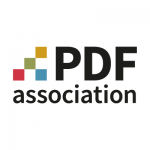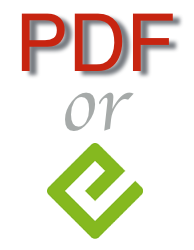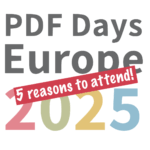PDF or EPUB?

The PDF Association staff delivers a vendor-neutral platform in service of PDF’s stakeholders.


 In early 2016 we find ourselves at an interesting place in the co-evolution of electronic document and digital publishing technologies.
In early 2016 we find ourselves at an interesting place in the co-evolution of electronic document and digital publishing technologies.
The printed page, and its PDF electronic equivalent, continues to grow even as web technologies create new vehicles of communication and interaction.
Web technologies clearly dominate dynamic content, and that is as it should be. As such, many websites are essentially navigation systems to help users find the PDF document they need. Once the author''s work is finished, however, most documents are not dynamic. To meet their need for self-contained, sharable, static content, individual human users create billions of PDF documents daily, while machines make, transform and deliver many billions more.
Although there is significant overlap between PDF and the web stack of HTML/CSS/JavasScript, the technologies are compatible, but not comparable. PDF has its place, as does the classical web stack. Neither is a capable replacement for the other.
Why PDF?
Although preceded by PostScript and AFP, PDF was the first page description technology to deliver an electronic page that matched the core features of paper.
A cross-platform page-painting, PDF pages can contain any two-dimensional content, from billboard artwork to financial statements to textbooks to prescription-bottle labels. Since PDF is self-contained on a page level, pages from various sources are readily combined or exchanged.
Achieving feature parity with paper allowed PDF to take on qualities that are vital to business documents but elude web technology, including fixed layouts, pagination, redaction, annotation, standardized navigation, page-spanning content and more.
At the same time PDF delivers a digital publishing solution that not only meets the most stringent requirements for print-ready content, but offers a reliable means of delivering carefully designed and laid-out content, and thus a means of generating revenue.
The dynamic aspects of web content, although vital to the experience of websites, hasn't diminished the utility of PDF. The Portable Document Format's feature-set remains essential.
Why EPUB?
EPUB is a specification for using web technologies to deliver a self-contained set of web-pages in a single file.
The premise is clear and compelling web-like capabilities are familiar and desirable to users, and publishers have lots of rich content to deliver.
EPUB was designed for delivery of publishers web-like content in a portable manner, and it excels at this task. The typical use-cases for EPUB documents include novels, content designed expressly for small-screens and other content with limited, straightforward layout requirements.
Certainly, PDF can perform well on smaller screens in a variety of ways, but EPUB can deliver smooth results in this context without complex structuring or specialized layouts.
How to choose
If your readers will prefer EPUB, give them EPUB. If they will prefer PDF, give them PDF. If they prefer a choice of PDF or EPUB, then give them that choice.
Some of the reasons to choose PDF
Although not every document is best delivered as PDF, there are many functional requirements for electronic documents that PDF alone can satisfy:
- Broad acceptance across the world and throughout every sector of the economy that handles electronic documents
- If usage might include combining pages from different sources, rearranging or otherwise managing pages after the file was first created (common use cases in business documents), choose PDF, as EPUB does not provide for these scenarios
- If color management is important, choose PDF, as EPUB does not offer color management
- If file encryption and digital signature features are significant, choose PDF, as these features arent standardized or commonly implemented within web technologies
- If longevity over decades is important, choose PDF, as it has proven out in the marketplace for over 20 years and includes a specific ISO-standardized subset to meet archival needs
- If you wish users to be able to add or manage annotations, choose PDF, as HTML does not include a standardized or widely implemented model for annotations
- If content may be redacted, choose PDF, as HTML does not support redaction
- If the state of the content (including form-field values) might change over the document's livecycle, choose PDF, as EPUB does not include a model for incremental saves of the document
- If both a fixed layout and accessibility are required, choose PDF, as accessible EPUB presupposes conventional (reflowable) files
- If sentences or logical structures such as paragraphs, lists and tables cross page boundaries, choose PDF, as the accessibility model for web technology does not address structures that span multiple pages




